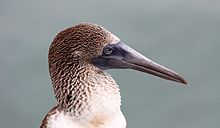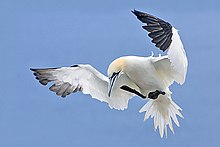Sulidae
| Sulidae | |
|---|---|

| |
| Brown booby, Sula leucogaster | |
| Scientific classification | |
| Domain: | Eukaryota |
| Kingdom: | Animalia |
| Phylum: | Chordata |
| Class: | Aves |
| Order: | Suliformes |
| Family: | Sulidae Reichenbach, 1849 |
Genera
| |
|
| |
| Synonyms | |
|
Enkurosulidae Kashin, 1977 | |
The
Description


Sulids measure about 60 to 85 cm (24 to 33 in) in length and have a wingspan around 140 to 175 cm (4.59 to 5.74 ft). They have long, narrow, and pointed wings, and a quite long, graduated, and rather lozenge-shaped tail whose outer feathers are shorter than the central ones. Their flight muscles are rather small to allow for the small cross-section required for plunge-diving, as an adaptive trade-off relative to some sacrifice in flight performance. Consequently, they are very streamlined, reducing drag, so their bodies are "torpedo-shaped" and somewhat flat.[5]
They have stout legs and
Their
Distribution and ecology
The sulids are distributed mainly in
All
As noted above, the
Reproduction

All sulids breed in

The
At hatching, parents move the eggs and then the hatchlings to the tops of their webs. The young hatch naked, but soon develop white
Systematics and evolution
Sulids are related to a number of other
| Sulid phylogeny | |||||||||||||||||||||||||||||||||||||||||||||||||||||||||
| |||||||||||||||||||||||||||||||||||||||||||||||||||||||||
| Cladogram showing the family Sulidae.[9] |
The Sulae were traditionally included in the
Within the family itself, three living genera—
| Species of boobies | ||
|---|---|---|
| Common and binomial names | Image | Range |
| Northern gannet (Morus bassanus) |

|
Western Europe and North America |
| Cape gannet (Morus capensis) |

|
West to Southwest African coast |
| Australasian gannet (Morus serrator or Sula bassana) |

|
Australia and New Zealand |
| Abbott's booby (Papasula abbotti) |

|
Christmas Island |
| Blue-footed booby (Sula nebouxii) |

|
Eastern Pacific Ocean from California to the Galápagos Islands south into Peru |
| Masked booby (Sula dactylatra) |

|
Tropical oceans between the 30th parallel north and 30th parallel south. In the Indian Ocean it ranges from the coastlines of the Arabian Peninsula and East Africa across to Sumatra and Western Australia |
| Nazca booby (Sula granti) |

|
Eastern Pacific from the islands in Baja California to the Galápagos Islands and the Isla de la Plata in Ecuador and Malpelo in Colombia |
| Brown booby (Sula leucogaster) |

|
Pantropical areas of the Atlantic and Pacific Oceans |
| Red-footed booby (Sula sula) |

|
Most tropical areas of oceans, main exceptions being tropical areas of E Atlantic and SE Pacific, breeding on islands |
| Peruvian booby (Sula variegata) |

|
Coast of South America from Peru to Chile |
The
Prehistoric sulids (or suloids) only known from fossils are:
- Masillastega (Early Eocene of Messel, Germany) – may belong in Eostega
- Eostega (Late Eocene of Cluj-Manastur, Romania) – may include Masillastega
- Sulidae gen. et sp. indet. (Thalberg Late Oligocene of Germany) – Empheresula?[11]
- Sulidae gen. et sp. indet. (Late Oligocene of South Carolina, United States) – Microsula?[12]
- Empheresula (Late Oligocene of Gannat, France – Middle Miocene of Steinheimer Becken, Germany) – including "Sula" arvernensis, "Parasula"[13]
- Microsula (Late Oligocene of South Carolina, United States – Grund Middle Miocene of Austria) – may belong in Morus or Sula, includes "Sula" avita, "S." pygmaea, Enkurosula, "Pseudosula"[1]
- Sarmatosula (Middle Miocene of Credinţa, Romania)
- Miosula (Late Miocene of California)
- Paleosula (Early Pliocene? of California)
- Rhamphastosula (Pisco Early Pliocene of SC Peru)
- Bimbisula (middle Pliocene of South Carolina)[14]
- Sulidae gen. et sp. indet. (Late Pliocene of Valle di Fine, Italy) – Morus?[15]
For prehistoric
The
References
- ^ Pseudosula as established by Boetticherin 1955: Mlíkovský (2002: p.67)
- ^ p.66
- ^
- DOI: 10.1642/0004-8038(2002)119[0820:MSFSSO]2.0.CO;2 PDF fulltext Archived 2016-03-03 at the Wayback Machine
- ^ a b c d e f g h Nelson, J. Bryan (2003): Gannets and Boobies. In: Perrins, C. (ed.): The Firefly Encyclopedia of Birds: 82–87. Firefly Books, Oxford.
- ^ Olson, Storrs L. (1985): Section X.G.5.a. Sulidae. In: The Fossil Record of Birds. Avian Biology 8: 203-204. PDF fulltext
- ^ p.100
- ^
- ^ PMID 21144905.
- ^ "Archived copy". Archived from the original on 2012-03-01. Retrieved 2011-06-30.
{{cite web}}: CS1 maint: archived copy as title (link) - ^ A distal humerus fragment; larger than Microsula: Göhlich (2003), Mayr (2009: p.65)
- ^ Some fossils that "do not differ substantially from modern [sulid] genera"; no further details given: Olson (1985: p.203)
- Parasula as established by Mathewsin 1913: Mlíkovský (2002: p.66)
- ^ Benson, Richard D.; Erickson, Bruce R. (2013). "A new genus and species of booby (Sulidae: Aves) from the Pliocene of South Carolina, with a new corollary to the nature of sister taxa". Science Museum Monographs in Paleontology. 7. St. Paul, MN: Science Museum of Minnesota.
- ^ A proximal humerus fragment somewhat similar to a gannet's: Lambrecht (1933: p.286)
- ^ Göhlich, Ursula B. (2003): The avifauna of the Grund Beds (Middle Miocene, Early Badenian, northern Austria). Annalen des Naturhistorischen Museums Wien A 104: 237-249 [English with German abstract]. PDF fulltext
Further reading
- Lambrecht, Kálmán(1933): Familia Sulidae. In: Handbuch der Palaeornithologie: 284-287 [German]. Gebrüder Bornträger, Berlin.
- Mlíkovský, Jirí (2007): Taxonomic identity of Eostega lebedinskyi LAMBRECHT, 1929 (Aves) from the middle Eocene of Romania. Annalen des Naturhistorischen Museums in Wien A 109: 19-27 [English with German abstract]. PDF fulltext
External links
- Live camera from Eldey Iceland
- Sulidae videos on the Internet Bird Collection
- FAMILY SULIDAE
